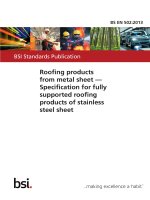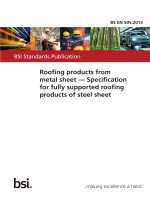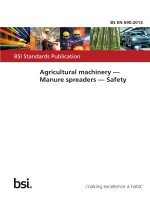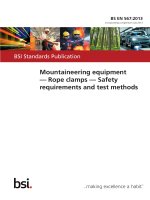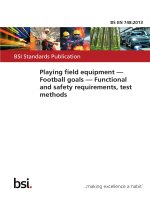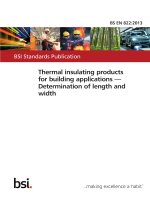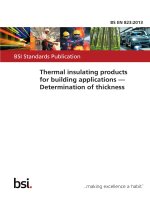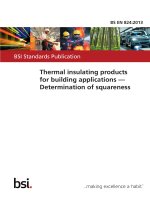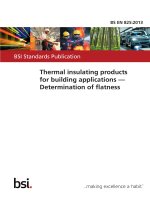Bsi bs en 62444 2013
Bạn đang xem bản rút gọn của tài liệu. Xem và tải ngay bản đầy đủ của tài liệu tại đây (2.27 MB, 34 trang )
BS EN 62444:2013
BSI Standards Publication
Cable glands for electrical
installations
BRITISH STANDARD
BS EN 62444:2013
National foreword
This British Standard is the UK implementation of EN 62444:2013. It is
identical to IEC 62444:2010. It supersedes BS EN 50262:1999 which is
withdrawn.
The CENELEC common modifications have been implemented at the
appropriate places in the text. The start and finish of each common
modification is indicated in the text by }~.
The UK participation in its preparation was entrusted to Technical
Committee PEL/213, Cable management.
A list of organizations represented on this committee can be obtained on
request to its secretary.
This publication does not purport to include all the necessary provisions of
a contract. Users are responsible for its correct application.
© The British Standards Institution 2014.
Published by BSI Standards Limited 2014
ISBN 978 0 580 82752 5
ICS 29.120.10
Compliance with a British Standard cannot confer immunity from
legal obligations.
This British Standard was published under the authority of the
Standards Policy and Strategy Committee on 28 February 2014.
Amendments/corrigenda issued since publication
Date
Text affected
BS EN 62444:2013
EUROPEAN STANDARD
EN 62444
NORME EUROPÉENNE
EUROPÄISCHE NORM
October 2013
ICS 29.120.10
English version
Cable glands for electrical installations
(IEC 62444:2010, modified)
Presse-étoupes pour installations
électriques
(CEI 62444:2010, modifiée)
Kabelverschraubungen für elektrische
Installationen
(IEC 62444:2010, modifiziert)
This European Standard was approved by CENELEC on 2013-09-23. CENELEC members are bound to comply
with the CEN/CENELEC Internal Regulations which stipulate the conditions for giving this European Standard
the status of a national standard without any alteration.
Up-to-date lists and bibliographical references concerning such national standards may be obtained on
application to the CEN-CENELEC Management Centre or to any CENELEC member.
This European Standard exists in three official versions (English, French, German). A version in any other
language made by translation under the responsibility of a CENELEC member into its own language and notified
to the CEN-CENELEC Management Centre has the same status as the official versions.
CENELEC members are the national electrotechnical committees of Austria, Belgium, Bulgaria, Croatia, Cyprus,
the Czech Republic, Denmark, Estonia, Finland, Former Yugoslav Republic of Macedonia, France, Germany,
Greece, Hungary, Iceland, Ireland, Italy, Latvia, Lithuania, Luxembourg, Malta, the Netherlands, Norway, Poland,
Portugal, Romania, Slovakia, Slovenia, Spain, Sweden, Switzerland, Turkey and the United Kingdom.
CENELEC
European Committee for Electrotechnical Standardization
Comité Européen de Normalisation Electrotechnique
Europäisches Komitee für Elektrotechnische Normung
CEN-CENELEC Management Centre: Avenue Marnix 17, B - 1000 Brussels
© 2013 CENELEC -
All rights of exploitation in any form and by any means reserved worldwide for CENELEC members.
Ref. No. EN 62444:2013 E
BS EN 62444:2013
EN 62444:2013
-2-
Foreword
This document (EN 62444:2013) consists of the text of IEC 62444:2010 prepared by IEC/TC 23
"Electrical accessories", together with the common modifications prepared by CLC/TC 213 "Cable
management systems".
The following dates are fixed:
•
•
latest date by which this document has to be
implemented
at national level by publication of an identical
national standard or by endorsement
latest date by which the national standards conflicting
with this document have to be withdrawn
(dop)
2014-09-23
(dow)
2016-09-23
This document supersedes EN 50262:1998.
EN 62444:2013 includes the following significant technical changes with respect to EN 50262:1998:
-
1 Scope
-
3 Terms and definitions
-
5 General conditions for tests
-
6 Classification
-
9 Mechanical properties
-
9.5 Resistance to impact
-
10.3.2 Electrical current test
-
12.2 Resistance to corrosion
-
Table 2 – Pull forces for cable retention and cable anchorage
Clauses, subclauses, notes, tables, figures and annexes which are additional to those in
IEC 62444:2010 are prefixed “Z”.
Attention is drawn to the possibility that some of the elements of this document may be the subject of
patent rights. CENELEC [and/or CEN] shall not be held responsible for identifying any or all such
patent rights.
This standard covers the Principle Elements of the Safety Objectives for Electrical Equipment
Designed for Use within Certain Voltage Limits (LVD - 2006/95/EC).
__________
-3-
BS EN 62444:2013
EN 62444:2013
Endorsement notice
The text of the International Standard IEC 62444:2010 was approved by CENELEC as a European
Standard with agreed common modifications.
BS EN 62444:2013
EN 62444:2013
-4-
Annex ZA
(normative)
Normative references to international publications
with their corresponding European publications
The following documents, in whole or in part, are normatively referenced in this document and are
indispensable for its application. For dated references, only the edition cited applies. For undated
references, the latest edition of the referenced document (including any amendments) applies.
NOTE When an international publication has been modified by common modifications, indicated by (mod), the relevant
EN/HD applies.
Publication
Year
Title
EN/HD
Year
IEC 60423
2007
Conduit systems for cable management Outside diameters of conduits for electrical
installations and threads for conduits and
fittings
EN 60423
2007
IEC 60529
+ A1
1989
1999
Degrees of protection provided by
enclosures (IP Code)
EN 60529
+ corr. May
+ A1
1991
1993
2000
IEC 60695-2-11
+ corr. January
2000
2001
Fire hazard testing Part 2-11: Glowing/hot-wire based test
methods - Glow-wire flammability test
method for end-products
EN 60695-2-11
2001
ISO 868
2003
Plastics and ebonite - Determination of
indentation hardness by means of a
durometer (Shore hardness)
EN ISO 868
2003
ISO 4287
1997
Geometrical Product Specifications (GPS) - EN ISO 4287
Surface texture: Profile method - Terms,
definitions and surface texture parameters
1998
ISO 9227
2006
Corrosion tests in artificial atmospheres Salt spray tests
2006
EN ISO 9227
BS EN 62444:2013
–2–
62444 © IEC:2010
CONTENTS
1
Scope ...............................................................................................................................6
2
Normative references .......................................................................................................6
3
Terms and definitions .......................................................................................................6
4
General requirements .......................................................................................................7
5
General conditions for tests ..............................................................................................8
6
Classification ....................................................................................................................9
7
6.1 According to material...............................................................................................9
6.2 According to mechanical properties .........................................................................9
6.3 According to electrical properties .......................................................................... 10
6.4 According to resistance to external influences ....................................................... 10
6.5 According to sealing system .................................................................................. 10
Marking and documentation ............................................................................................ 11
8
7.1 Marking ................................................................................................................. 11
7.2 Durability and legibility .......................................................................................... 11
7.3 Documentation ...................................................................................................... 11
Construction ................................................................................................................... 12
9
Mechanical properties .................................................................................................... 12
9.1 General ................................................................................................................. 12
9.2 Cable retention test ............................................................................................... 13
9.3 Cable anchorage test for non-armoured cable ....................................................... 15
9.4 Cable anchorage test for armoured cable .............................................................. 17
9.5 Resistance to impact ............................................................................................. 19
9.6 Seal performance .................................................................................................. 22
10 Electrical properties........................................................................................................ 22
10.1 Equipotential bonding to electrical equipment ........................................................ 22
10.2 Equipotential bonding to metallic layer(s) of cable ................................................. 22
10.3 Protective connection to earth ............................................................................... 23
10.3.1 General ..................................................................................................... 23
10.3.2 Electrical current test................................................................................. 23
11 Electromagnetic compatibility ......................................................................................... 24
12 External influences ......................................................................................................... 25
12.1 Degree of protection in accordance with IEC 60529 (IP Code)............................... 25
12.1.1 General ..................................................................................................... 25
12.1.2 Degree of protection against foreign solid objects...................................... 25
12.1.3 Degree of protection against ingress of water ............................................ 25
12.2 Resistance to corrosion ......................................................................................... 25
12.3 Resistance to ultraviolet light................................................................................. 25
13 Fire hazard ..................................................................................................................... 26
13.1 Reaction to fire ...................................................................................................... 26
13.1.1 General ..................................................................................................... 26
13.1.2 Contribution to fire ..................................................................................... 26
13.1.3 Spread of fire ............................................................................................ 26
13.2 Resistance to fire .................................................................................................. 26
BS EN 62444:2013
62444 © IEC:2010
–3–
Annex A (normative) Particular requirements for cable glands for electrical
installations with NPT entry threads ...................................................................................... 27
Annex B (informative) Test sequence................................................................................... 28
Bibliography.......................................................................................................................... 29
Figure 1 – Typical arrangement for cable retention test......................................................... 14
Figure 2 – Typical arrangement for cable anchorage pull test ............................................... 16
Figure 3 – Typical arrangement for cable anchorage twist test .............................................. 17
Figure 4 – Typical arrangement for cable anchorage test for armoured cable........................ 18
Figure 5 – Typical arrangement for impact test ..................................................................... 21
Figure 6 – Typical arrangement for electrical current tests .................................................... 24
Table 1 – Clearance holes for cable glands for test purposes ................................................. 9
Table 2 – Pull forces for cable retention and cable anchorage .............................................. 15
Table 3 – Torque value for cable anchorage twist test .......................................................... 17
Table 4 – Impact values ........................................................................................................ 20
Table 5 – Electrical current values ........................................................................................ 23
Table A.1 – Clearance holes for NPT cable glands for test purposes .................................... 27
BS EN 62444:2013
–6–
62444 © IEC:2010
CABLE GLANDS FOR ELECTRICAL INSTALLATIONS
1
Scope
This Standard provides requirements and tests for the construction and performance of cable
glands. This standard covers complete cable glands as supplied by the manufacturer or the
supplier responsible for placing the product on the market. This standard does not cover cable
glands for mineral insulated cables.
This standard covers cable glands with IEC 60423 metric entry threads.
}Text deleted~
NOTE Certain cable glands may also be used “in Hazardous Areas.” Regard should then be taken of other or
additional requirements necessary for the enclosure to be installed in such conditions, for example as specified in
the IEC 60079 series.
2
Normative references
}See Annex ZA.~
3
Terms and definitions
For the purposes of this document, the following definitions apply.
3.1
cable gland
a device designed to permit the entry of a cable, flexible cable or insulated conductor into an
enclosure, and which provides sealing and retention. It may also provide other functions such
as earthing, bonding, insulation, cable guarding, strain relief or a combination of these
3.2
entry thread
the threaded portion of a cable gland which is intended to be attached to an enclosure or
equipment
3.3
cable gland size
the nominal diameter of the entry thread
3.4
cable retention
the minimum ability of a cable gland to limit the displacement of a fitted cable under static
load
BS EN 62444:2013
62444 © IEC:2010
–7–
3.5
cable anchorage
the ability of a cable gland to limit the displacement of a fitted cable under dynamic and
torque loads
3.6
series
cable glands of the same classification and design but with different dimensions
3.7
clearance hole
unthreaded opening in an enclosure or equipment intended to permit entry of a cable gland
3.8
metallic cable gland
cable gland which consists of metallic material only
NOTE
Sealing systems are excluded from this definition.
3.9
non-metallic cable gland
cable gland which consists of non-metallic material only
NOTE
Sealing systems are excluded from this definition.
3.10
composite cable gland
cable gland comprising both metallic and non-metallic materials
NOTE
Sealing systems are excluded from this definition.
3.11
single-orifice seal
seal with one orifice suitable for the passage of a single cable
3.12
multi-orifice seal
seal with more than one orifice, each orifice being suitable for the passage of a separate
cable
4
General requirements
Cable glands shall be designed to provide in normal use all the functions declared by the
manufacturer or supplier.
BS EN 62444:2013
–8–
5
62444 © IEC:2010
General conditions for tests
5.1
Tests according to this standard are type tests.
5.2 Unless otherwise specified, the tests shall be carried out on new cable glands
assembled and mounted in accordance with the manufacturer’s or supplier’s instructions, as
declared in 7.3.
There shall be no adjustment between or during the tests.
NOTE
Remounting of the sample between tests is not considered to be adjustment.
5.3 Unless otherwise specified, the tests shall be carried out at an ambient temperature of
(20 ± 5) °C.
5.4 Non-metallic and composite cable glands as well as the sealing systems of metallic
cable glands shall be pre-conditioned in an oven at (70 ± 2) °C and maintained for
(168 ± 4) h. If the maximum temperature declared by the manufacturer is greater than 65 °C,
then the test temperature shall be the declared temperature +5 °C.
5.5 Prior to the tests, non-metallic and composite cable glands as well as the sealing
systems of metallic cable glands shall be conditioned at a temperature of (20 ± 5) ºC and a
relative humidity between 40 % and 60 % for a minimum of 24 h or longer as specified by the
manufacturer.
5.6
Unless otherwise specified, three samples shall be subjected to the relevant tests.
In the case of a series of cable glands, three samples of the largest and smallest and one
sample of all other sizes of the same series shall be subjected to the relevant tests.
In the case of a cable gland utilising alternative sealing arrangements, each sealing
arrangement as specified by the manufacturer or supplier shall be considered as a sample.
If a sample does not satisfy a test due to an assembly or manufacturing fault, that test and
any preceding one which may have influenced the results of the test shall be repeated on 3
new samples of the size that failed. The tests which follow shall be made in the required
sequence. All new samples shall fulfil the requirements.
5.7 Unless otherwise specified test mandrels shall consist of bars having a hardness of
65 Shore D ± 15 points in accordance with ISO 868 and a surface roughness less than or
equal to 7 µm R a in accordance with ISO 4287. The test mandrel shall have a tolerance of
± 0,2 mm for test mandrels up to and including 16 mm in diameter and ± 0,3 mm for test
mandrels larger than 16 mm in diameter. The shape shall be circular or a profile simulating
the outer dimension of the cables as declared by the manufacturer or supplier.
5.8 Clearance holes for test purposes shall have the values as given in Table 1, unless
otherwise specified by the manufacturer or supplier.
NOTE
Annex B shows test sequences which shall be used for guidance only.
BS EN 62444:2013
62444 © IEC:2010
–9–
Table 1 – Clearance holes for cable glands for test purposes
6
Cable gland size
Thread size
Clearance hole diameter
mm
6
M6
6 (0/ +0,2)
8
M8
8 (0/ +0,2)
10
M 10
10 (0/ +0,2)
12
M 12
12 (0/ +0,2)
16
M 16
16 (0/ +0,2)
20
M 20
20 (0/ +0,2)
25
M 25
25 (0/ +0,2)
32
M 32
32 (0/ +0,3)
40
M 40
40 (0/ +0,3)
50
M 50
50 (0/ +0,4)
63
M 63
63 (0/ +0,4)
75
M 75
75 (0/ +0,5)
90
M 90
90 (0/ +0,5)
110
M 110
110 (0/ +0,5)
Classification
Cable glands shall be classified for test purposes in accordance with 6.1, 6.2 and 6.5 and
where appropriate, with 6.3 and 6.4.
6.1
According to material
6.1.1
Metallic cable glands
6.1.2
Non-metallic cable glands
6.1.3
Composite cable glands
6.2
According to mechanical properties
6.2.1
Non-armoured cable retention or anchorage
6.2.1.1
Anchorage Type A
6.2.1.2
Anchorage Type B
6.2.1.3
Retention only
6.2.2
Armoured cable anchorage
6.2.2.1
Anchorage Type C
6.2.2.2
Anchorage Type D
6.2.3
Impact category
BS EN 62444:2013
– 10 –
6.2.3.1
Category 1
6.2.3.2
Category 2
6.2.3.3
Category 3
6.2.3.4
Category 4
6.2.3.5
Category 5
6.2.3.6
Category 6
6.2.3.7
Category 7
6.2.3.8
Category 8
6.3
According to electrical properties
6.3.1
With electrical continuity characteristics
6.3.1.1
Equipotential bonding to enclosure
6.3.1.2
Equipotential bonding to metallic layer(s) of cable
62444 © IEC:2010
NOTE A metallic layer may be provided for purposes such as earthing, screening, armouring or mechanical
protection.
6.3.1.3
Cable glands with connection to protective earth
6.3.1.3.1
Category A
6.3.1.3.2
Category B
6.3.1.3.3
Category C
6.4
According to resistance to external influences
6.4.1
Degree of protection in accordance with IEC 60529 (IP Code) with a minimum of IP54
6.4.2
Temperature range if different from that defined in Subclause 8.5
6.4.3
Resistance to ultraviolet light for non-metallic cable glands
6.4.3.1
Resistance to ultraviolet light not declared
6.4.3.2
Resistant to ultraviolet light
6.5
According to sealing system
6.5.1
With a single-orifice seal
6.5.2
With a multi-orifice seal
NOTE
For cable glands used for armoured cable this standard only addresses single-orifice type sealing systems.
BS EN 62444:2013
62444 © IEC:2010
7
7.1
– 11 –
Marking and documentation
Marking
The cable gland shall be legibly and durably marked in a visible place with the following:
–
name, logo or registered mark of the manufacturer or supplier;
–
identification of the product.
Where it is not possible to apply the marking directly onto the product, then the marking shall
be placed on the smallest supplied package.
Compliance is checked by inspection.
Marking on the product not made by pressing, moulding or engraving is tested in accordance
with 7.2.
7.2
Durability and legibility
The test is made by rubbing the marking by hand for 15 s with a piece of cotton cloth soaked
with water and again for 15 s with a piece of cotton cloth soaked in petroleum spirit.
NOTE Petroleum spirit is defined as the aliphatic solvent hexane with a content of aromatics of maximum 0,1 %
volume, a kauri-butanol value of 29, initial boiling point of 65 °C, a dry point of 69 °C and a specific gravity of
approximately 0,68 kg/l.
After this test, the marking shall be legible to normal or corrected vision without additional
magnification.
The marking shall remain legible after all the non-destructive tests of this standard. It shall not
be possible to remove labels easily and they shall not show curling.
Compliance is checked by inspection.
7.3
Documentation
The manufacturer or supplier shall provide in his literature all information necessary for the
proper use and safe installation, such as
–
sealing range (maximum and minimum cable dimensions);
–
installation torque, if any;
–
entry thread length, if any;
–
entry thread size and type;
–
maximum clearance hole diameter;
–
type of cable anchorage and anchorage range, if any;
–
impact category;
–
correct assembly of the cable gland for use as part of the protective earth conductor or
electrical connection;
–
degree of protection in accordance with IEC 60529 (IP Code) if higher than IP 54;
–
temperature range if different from Subclause 8.5;
–
multi-orifice seals if any.
Compliance is checked by inspection.
BS EN 62444:2013
– 12 –
8
62444 © IEC:2010
Construction
8.1 Those parts of a cable gland that are used for tightening or holding during installation
shall be suitable for gripping without damage to the cable gland or cable with commonly
available tools or following the manufacturer’s instructions. For sizes up to and including
M110, the entry thread, if any, shall be constructed in accordance with IEC 60423, Table 1.
Compliance is checked by measurement or manual test.
8.2 All external projecting edges and corners of cable gland components shall be smooth to
prevent danger of injury in handling the cable gland.
Compliance is checked by inspection and manual test.
8.3 Cable glands shall be constructed to avoid cable damage when installed in accordance
with the manufacturer’s or supplier’s instructions.
Compliance is checked by inspection.
8.4
Cable glands shall provide a minimum degree of IP54 in accordance with IEC 60529.
Compliance is checked in accordance with 12.1.
8.5 Cable glands shall be suitable for use within a temperature range from at least –20 °C to
at least 65 °C.
A temperature exceeding this range can be declared by the manufacturer or supplier.
Compliance is checked in accordance with pre-conditioning in 5.4 and the test in 9.5.
8.6
Metallic parts shall be resistant to or protected against corrosion.
Compliance is checked in accordance with 12.2.
8.7 Cable glands declared in accordance with 6.4.3.2 shall have adequate resistance to
ultra-violet light.
Compliance is checked in accordance with 12.3.
9
9.1
Mechanical properties
General
Cable glands declared in accordance with 6.2.1.3 shall provide minimum cable retention in
accordance with Table 2 column "Cable retention".
Compliance is checked in accordance with the test in 9.2.
Cable glands declared in accordance with 6.2.1.1 shall provide cable anchorage in
accordance with Table 2 "Type A".
Cable glands declared in accordance with 6.2.1.2 shall provide cable anchorage in
accordance with Table 2 "Type B".
Compliance is checked in accordance with the test in 9.3.
BS EN 62444:2013
62444 © IEC:2010
– 13 –
Cable glands declared in accordance with 6.2.2.1 shall provide cable anchorage in
accordance with Table 2 "Type C". Cable glands declared in accordance with 6.2.2.2 shall
provide cable anchorage in accordance with Table 2 "Type D".
Compliance is checked in accordance with the test 9.4.
9.2
Cable retention test
For cable glands classified according to 6.2.1.3 and with a sealing system in accordance with
6.5.1, a test mandrel equivalent to the minimum value of the sealing range of the cable gland
as declared by the manufacturer or supplier is fixed to the cable gland.
For cable glands classified according to 6.2.1.3 and with a sealing system in accordance with
6.5.2, a test mandrel equivalent to the minimum value of the sealing range of the smallest
orifice of the cable gland is fixed into the smallest orifice of the cable gland and each
remaining orifice is plugged with a plug equivalent to the minimum value of its sealing range.
A circular test mandrel is loaded until the pull force is in accordance with the values given in
Table 2 column “Cable retention”.
For test mandrels which are not circular in shape, i.e. where non-circular cables are being
simulated, their cross-sectional area shall be determined, and the diameter of a circular cable
of the same cross-sectional area shall be calculated. The test values shall be appropriate to
the nearest circular test mandrel size.
For cable glands with sealing systems comprising two or more seals with different sizes, the
mandrel shall be stepped appropriately. The test values shall be appropriate to the largest
test mandrel diameter.
The test mandrel is marked when unloaded so that any displacement relative to the cable
gland can be easily detected.
The load is maintained for 5 min and at the end of this period the displacement shall not
exceed 3 mm when unloaded.
The test is repeated using new samples and a test mandrel equivalent to the maximum value
of the sealing range of the cable gland as declared by the manufacturer or supplier, with the
test value of the relevant maximum cable diameter specified in Table 2.
A typical arrangement for the cable retention test is shown in Figure 1.
BS EN 62444:2013
62444 © IEC:2010
– 14 –
3
1
2
3
5
N
4
IEC 1972/10
Key
1
locknut
2
cable gland
3
mandrel
4
load
5
support
Figure 1 – Typical arrangement for cable retention test
BS EN 62444:2013
62444 © IEC:2010
– 15 –
Table 2 – Pull forces for cable retention and cable anchorage
Cable diameter
9.3
Cable
retention
Cable anchorage for
Cable anchorage for
non-armoured cable
armoured cable
Type A
Type B
Type C
Type D
mm
N
N
N
N
N
Up to 4
5
–
–
-
-
> 4 to 8
10
30
75
75
640
> 8 to 11
15
42
120
120
880
> 11 to 16
20
55
130
130
1 280
> 16 to 23
25
70
140
140
1 840
> 23 to 31
30
80
250
250
2 480
> 31 to 43
45
90
350
350
3 440
> 43 to 55
55
100
400
400
4 400
> 55
70
115
450
450
5 600
Cable anchorage test for non-armoured cable
Cable glands declared with cable anchorage in accordance with 6.2.1.1 and 6.2.1.2 shall
relieve the conductors from strain, including twisting.
Compliance is checked by the following tests.
For cable glands with a sealing system in accordance with 6.5.1, a test mandrel equivalent to
the minimum value of the anchorage range of the cable gland as declared by the
manufacturer or supplier is fixed to the sample.
For cable glands with a sealing system in accordance with 6.5.2, a test mandrel equivalent to
the minimum value of the anchorage range of the smallest orifice of the cable gland is fixed
into the smallest orifice of the sample, and each remaining orifice is plugged with a plug
equivalent to the minimum value of its sealing range.
The test mandrel is marked when unloaded so that any displacement relative to the cable
gland can be easily detected.
The test mandrel is pulled 50 times for a duration of 1 s without jerks in the direction of its
axis with the relevant pull force specified in Table 2.
At the end of this period the displacement shall not exceed 2 mm. This measurement is to be
carried out after unloading the force from the test mandrel.
A typical arrangement for the cable anchorage pull test is shown in Figure 2.
BS EN 62444:2013
62444 © IEC:2010
– 16 –
3
2
8
4
5
6
7
1
9
IEC 1973/10
Key
1
crank arm
2
off centre pulley
3
pivot point
4
mandrel
5
cable gland
6
locknut
7
load retaining device
8
fulcrum point
9
load in N
Figure 2 – Typical arrangement for cable anchorage pull test
The sample with the test mandrel is then mounted onto the test arrangement for the cable
anchorage twist test as shown in Figure 3.
The test mandrel is marked when unloaded so that any displacement can be easily detected
and then is subjected for 1 min to the torque as shown in Table 3.
During this test the test mandrel shall not turn by more than an angle of 45°.
The pull and twist tests shall be repeated using a test mandrel equivalent to the maximum
value of the anchorage range of the cable gland as declared by the manufacturer or supplier
with the test value of the relevant maximum cable diameter specified in Tables 2 and 3.
BS EN 62444:2013
62444 © IEC:2010
– 17 –
Table 3 – Torque value for cable anchorage twist test
Cable diameter
Torque
mm
Nm
> 4 to 8
0,10
> 8 to 11
0,15
> 11 to 16
0,35
> 16 to 23
0,60
> 23 to 31
0,80
> 31 to 43
0,90
> 43 to 55
1,00
> 55
1,20
8
2
1
3
4
5
6
7
9
10
10
IEC 1974/10
Key
1
bearings enabling easy rotation
2
device for securing test mandrel
3
test mandrel
4
sample
5
sample securing plate
(interchangeable )
6
rotating indicator
7
direction of rotation
8
fixed rotating indicator
9
radius
10
load in N
Figure 3 – Typical arrangement for cable anchorage twist test
9.4
Cable anchorage test for armoured cable
Two samples, each consisting of two cable glands, are assembled. In the first sample, the
cable glands are fitted, one at each end, to a cable 300 mm long, with the maximum over
armour diameter as declared by the manufacturer or supplier. In the second sample the cable
glands are fitted, one at each end, to a cable 300 mm long, with the minimum over armour
diameter as declared by the manufacturer or supplier.
BS EN 62444:2013
62444 © IEC:2010
– 18 –
For each sample, one cable gland is fixed and the other cable gland is loaded in accordance
with the appropriate value given in Table 2.
The cable is marked so that any displacement relative to each cable gland can be easily
detected.
The load is maintained for 5 min and at the end of this period the displacement shall not
exceed 3 mm at either cable gland.
A typical arrangement for cable anchorage test for armoured cable is shown in Figure 4.
Following the test, the samples of cable glands classified in accordance with 6.3.1.2 shall
then be subjected to the test in accordance with 10.2. Following the test, the samples of cable
glands classified in accordance with 6.3.1.3 are then subjected to the test in accordance with
10.2 followed by the test in accordance with 10.3.2.
300 mm
1
2
3
IEC 1975/10
Key
1
fixed cable gland
2
cable gland
3
load in N
Figure 4 – Typical arrangement for cable anchorage test for armoured cable
BS EN 62444:2013
62444 © IEC:2010
9.5
– 19 –
Resistance to impact
Cable glands shall be resistant to impact as classified according to 6.2.3.
Compliance is checked by the following test.
For cable glands with a sealing system in accordance with 6.5.1, a test mandrel equivalent to
the minimum value of the sealing range of the cable gland as declared by the manufacturer or
supplier is fixed to the sample and then the test is carried out at the minimum temperature in
accordance with 8.5 or lower if declared by the manufacturer.
For cable glands with a sealing system in accordance with 6.5.2, a test mandrel equivalent to
the minimum value of the sealing range of the smallest orifice of the cable gland is fixed into
the smallest orifice of the sample, and each remaining orifice is plugged with a plug
equivalent to the minimum value of its sealing range.
The test is carried out at the minimum temperature in accordance with 8.5 or lower if declared
by the manufacturer.
Prior to the impact test the samples shall be placed in a refrigerator for 8 h minimum.
The test temperature tolerance is ± 2 °C.
The testing can be done
–
inside the refrigerator at the declared minimum temperature, or
–
outside the refrigerator at ambient temperature (20 ± 5) °C if the cable gland previously
was cooled down to the declared minimum temperature in accordance with 8.5 minus 5 °C
and the impact is carried out within (15 ± 2) s after the cable gland was removed from the
refrigerator.
For example, if the declared temperature is –20 °C and the test is carried out outside the
refrigerator, then the cooling temperature shall be –25 °C.
The point of impact shall be the place considered to be weakest.
The sample shall be mounted on a steel base so that
–
the direction of impact is perpendicular to the surface being tested if it is flat, or
perpendicular to the tangent of the surface at the point of impact if it is not flat;
–
there is no movement of the cable gland support which could influence the test results.
The mass shall be fitted with an impact head of hardened steel in the form of a hemisphere of
25 mm diameter.
The base shall have a mass of at least 20 kg or be rigidly fixed or inserted into the floor.
A typical arrangement for the impact test is shown in Figure 5.
The sample is subjected to the impact energy as given in Table 4 according to the category
declared by the manufacturer of supplier.
BS EN 62444:2013
62444 © IEC:2010
– 20 –
Table 4 – Impact values
Category
1
2
3
4
5
6
7
8
0,2
0,5
1,0
2,0
4,0
7,0
10,0
20,0
±10%
±10%
±10%
±5%
±5%
±5%
±5%
±5%
Mass
kg
0,2
0,2
0,2
0,2
1,0
1,0
1,0
2,0
Height
m
0,10
0,25
0,5
1,0
0,4
0,7
1,0
1,0
Energy
J
NOTE
Mass and height may vary in degrees necessary to achieve the required energy.
After the test there shall be no sign of disintegration nor shall there be any cracks visible to
normal or corrected vision.
The sample shall then be subjected to the appropriate tests in accordance with 12.1 but
considering the classification according to 6.4.1 if declared by the manufacturer or supplier.
BS EN 62444:2013
62444 © IEC:2010
– 21 –
1
2
3
4
11
10
5
6
9
7
8
IEC 1976/10
Key
1
lifting line
2
guide tube
3
guide tube support
4
height scale
5
impact column support
6
test mandrel
7
cable gland
8
base
9
cable gland support
10
mass with impact head
11
height H
Figure 5 – Typical arrangement for impact test
BS EN 62444:2013
– 22 –
9.6
62444 © IEC:2010
Seal performance
For cable glands with a sealing system in accordance with 6.5.1, a test mandrel equivalent to
the maximum value of the sealing range of the cable gland as specified by the manufacturer
or supplier is fixed to the sample with the torque declared by the manufacturer or supplier.
For cable glands with a sealing system in accordance with 6.5.2, a test mandrel equivalent to
the maximum value of the sealing range of the smallest orifice of the sample is fixed, each
remaining orifice is plugged with a plug equivalent to the maximum value of its sealing range
and then the torque declared by the manufacturer or supplier is applied.
The sample shall then be subjected to the appropriate tests in accordance with 12.1, but
considering the classification according to 6.4.1 if declared by the manufacturer or supplier.
10 Electrical properties
10.1
Equipotential bonding to electrical equipment
Cable glands declared in accordance with 6.3.1.1 shall have adequate conductivity to the
electrical equipment.
The cable gland shall be mounted following the manufacturer’s instructions.
Compliance is checked on samples by measuring the resistance between the bonding
terminal or bonding contact of the cable gland and each of the accessible metal parts of the
cable gland in turn.
The resistance shall not exceed 0,1 Ω .
NOTE The cable gland may be assembled to a metallic plate and the resistance measured between the plate and
the cable gland.
10.2
Equipotential bonding to metallic layer(s) of cable
Cable glands declared in accordance with 6.3.1.2 shall ensure adequate electrical connection
with the metallic layer(s) of the cable.
This test is carried out after the test in 9.4. Two cable glands shall be assembled to a 300 mm
length of cable, one on each end.
The cable diameter shall be the smallest size of cable declared by the manufacturer or
supplier. If the smallest size of cable is not available the nearest available size can be used.
For each sample, one cable gland is fixed and the other cable gland is loaded in accordance
with the appropriate value given in Table 2. The load is maintained for 5 min and removed
accordingly.
Compliance is checked by measuring the resistance between the metallic layer(s) of the cable
fixed to the cable gland and the cable gland as close as possible to the connection or as
specified by the manufacturer or supplier.
The resistance shall not exceed 0,1 Ω .
